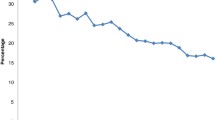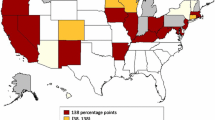Abstract
Health insurance is regulated at the state level by the use of state-mandated health benefits. These are regulations issued by the state that mandate minimum levels of certain benefits as part of policies offered, e.g., drug abuse and alcohol treatment services, treatment for mental illnesses, etc. In this paper, we evaluate the impact of state health insurance mandates on job creation by small firms using data from the Survey of Income and Program Participation (SIPP) dataset for the period 1993–1995. Results from an ordered probit regression indicate that, the larger the number of mandates in a state, the lower the probability that a self-employed person will be a significant employment generator. These results hold when we consider both the sum of mandates as well as a cost-weighted measure of the most expensive mandates.

Similar content being viewed by others
Notes
For instance, Davis et al. (1996) find that the rate of gross job creation in US manufacturing is nearly double for firms with fewer than 100 employees as compared with firms with more than 25,000 employees.
According to Census, “Nonemployers account for roughly 3% of business activity [in terms of sales or receipts]. At the same time nonemployers account for nearly three-quarters of all businesses. Most nonemployer businesses are very small, and many are not the primary source of income for their owners.” See the US Census Bureau, Nonemployer Statistics for more detailed information.
Overall, in 2002, there were approximately 2.7 million firms with 0–4 employees and 1 million firms with 5–9 employees, out of a total of approximately 5.7 million firms. http://www.sba.gov/advo/stats/st.pdf.
Bartelsman et al. (2005).
There are mandated providers as well, but we have only included mandated benefits in our study.
For example, the mental health illness mandate in Montana specifies that firms must offer a minimum 30 days of inpatient services.
This could be due to adverse selection, or undervaluation of benefits by insurance purchasers.
General Accounting Office (GAO) (1996).
One study found that mandated coverage increases insurance premiums by 6–8% for substance abuse, 10–13% for outpatient mental health care, and 21% for psychiatric hospital care for employee dependents (National Council for Policy Analysis, NCPA - BA #224 - An Easy Way to Make Health Insurance More Expensive).
GAO (1996).
Larger companies and organizations such as trade unions avoided the mandates through the Employee Retirement Income Security Act (ERISA). ERISA was intended to permit companies with, say, 1,000 or more employees, especially those operating in a number of states, to self-insure. When employees incur health care expenses under a self-insured employer, the employer rather than an insurance company pays the bill.
Gruber and Poterba (1994).
Coverage varies substantially by firm size: 55% of the smallest companies (3–9 workers) offer health insurance. That rises to 74% for firms with 10–24 workers and 88% for businesses with 25–49 employees. Firms with many part-time workers are less likely to offer health insurance. Firms that employ union workers are very likely (92%) to offer coverage regardless of size.
Workers in the smallest businesses that do provide health insurance pay, on average, 17% more for health benefits than workers employed by large companies.
NFIB estimates that health premium costs have gone up in the last 5 years by more than 20%.
Other papers have studied impact of mandates on employment or wages. Gruber (1994) finds no impact of mandated maternity benefits on the probability of a married woman of child-bearing age being employed, though they find that wages for this group fell by about 4%.
For the grouped states, I use sample population weighted averages of these variables.
In general, most variables refer to a reference period preceding the interview month. So, for instance, business profit income refers to average monthly income earned by the business owner over the previous 4 months. This is similarly true for average family incomes and wealth, and questions relating to home ownership. The results hold even when we include annual averages of these variables on the right-hand side. The number of employees hired by the business, however, reflects the current state of the firm. Therefore, there should be no issues of reverse causality arising out of our specification.
Even though the Carroll et al. (2000) study has a variable measuring the wage bill for the sole proprietor, this is not included as an explanatory variable in the employment regression. The reason the paper gives for this is that it is impossible to distinguish between the wage rate and the labor demand effect from a composite measure of the wage bill. Henley (2005) also does not include a measure of labor costs in the regressions.
The 2002 SEHBS surveyed 502 small (2–50 employees) firms that offered benefits and 498 firms that did not. A summary of the findings is available at: http://bcbshealthissues.com/proactive/newsroom/release.vtml?id=37339&PROACTIVE_ID=cecdcbc6c9ccc8cbcbc5cecfcfcfc5cecdcfc9cacccdccc9cac5cf.
This problem cannot be resolved by including more years in the data. The variation in mandates is very limited over time. Every year only a very few states (five or six) make changes to their mandates. Therefore, even if we included additional years, it would still not be possible for us to rely only on variation over time (by controlling for non-time-varying state effects) to identify the effect of mandates on employment.
These states are: Alaska, Illinois, Iowa, Kentucky, Maryland, Missouri, Montana, New Mexico, North Dakota, Rhode Island, Virginia, and Washington.
Congressional Research Service (1988), “Health Insurance and the Uninsured: Background Data and Analysis. Washington DC, US Government Printing Office.
References
Baicker, K. & Levy, H. (2007). Employer health insurance mandates and the risk of unemployment. NBER Working paper no. 13528.
Bartelsman, E., Scarpetta, S., & Shivardi, F. (2005). Comparative analysis of firm demographics and survival: Evidence from micro-level sources in OECD countries. Industrial and Corporate Change, 14, 365–391.
Bruce, D. (2000). Effect of the US tax system on transitions to self-employment. Labor Economics, 7(5), 545–574.
Burke, A., Fitzroy, F., & Nolan, M. (2002). Self-employment wealth and job creation: The roles of gender, non-pecuniary motivation and entrepreneurial ability. Small Business Economics, 19, 255–270.
Carroll, R., Holtz-Ekin, D., Rider, M., & Rosen, H. (2000). Income taxes and entrepreneurs’ use of labor. Journal of Labor Economics, 18(2).
Cowling, M., & Mitchell, P. (1997). The evolution of U.K. self-employment: A study of government policy and the role of the macroeconomy. The Manchester School, LXV(4), 427–442.
Cowling, M., Taylor M., & Mitchell, P. (2004). Job creators. The Manchester School, 72(5).
Cullen, J., & Gordon, R. (2002). Taxes and entrepreneurial activity. NBER Working paper 9015.
Davis, S. J., Haltiwanger, J., & Schuh, S. (1996). Small business and job creation: dissecting the myth and reassessing the fact. Small Business Economics, 8(4).
Evans, D., & Jovanovic, B. (1989). An estimated model of entrepreneurial choice under liquidity constraints. Journal of Political Economy, 97, 808–827.
Evans, D., & Leighton, L. (1989). Some empirical aspects of entrepreneurship. American Economic Review, 79, 519–535.
Fan, W., & White, M. (2003). Personal bankruptcy and the level of entrepreneurial activity. Journal of Law and Economics, 46(2), 543–568.
Gabel, J. R., & Jensen, G. A. (1989). The price of state mandated benefits. Inquiry, 26, 419–431.
Gabel, J. R., & Jensen, G. A. (1992). State mandated benefits and the small firm’s decision to offer health insurance. Journal of Regulatory Economics, 4, 379–404.
General Accounting Office. (1996). Health insurance regulation: Varying state requirements affect cost of insurance. Available at: http://www.gao.gov/archive/1996/he96161.pdf.
General Accounting Office. (2003). Private health insurance:federal and state requirements affecting coverage offered by small businesses. www.gao.gov/cgi-bin/getrpt?GAO-03-1133.
Georgellis, Y., & Wall, H. (2002). Entrepreneurship and the policy environment. Federal Reserve Bank at St. Louis Working Paper 2002-019A.
Greene, H (1996) Econometrics (4th ed.), (pp. 927–933).
Gruber, J. (1992). State mandated benefits and employer provided health insurance. NBER Working paper no. 4239.
Gruber, J. (1994). State mandated benefits and employer provided health insurance. Journal of Public Economics, 55, 433–464.
Gruber, J., & Poterba J. (1994). Tax incentives and the decision to purchase health insurance: Evidence from the self-employed. Quarterly Journal of Economics, 109(3).
Henley, A. (2005). Job creation by the self-employed: The roles of entrepreneurial and financial capital. Small Business Economics, Springer, 25(2), 175–196.
Holtz-Eakin, D., Joulfaian, D., & Rosen, H. (1994). Entrepreneurial survival and liquidity constraints. Journal of Political Economy, 102(1), 53–75.
Holtz-Eakin, D., Penrod, J., & Rosen H. (1996). Health insurance and the supply of entrepreneurs. Journal of Public Economics, 62, 209–235.
Jensen, G. A., & Morrisey, M. A. (1999). Small group reform and insurance provision by small firms, 1989–1995. Inquiry, 36(2), 176–187.
Kaestner, R., & Simon, K. (2002). Labor market consequences of state health insurance regulation. Industrial and Labor Relations Review, 56(1), 136–159.
Kangasharju, A., & Pekkala S. (2001). The role of education in self-employment success. Studies in Economics 0116, Department of Economics, University of Kent.
Meager, N., Bates, P., & Cowling, M. (2003). An evaluation of business start-up support for young people. National Institute Economic Review, 186, 59.
Meyer, B. (1990). Why are there so few Black Entrepreneurs? NBER Working paper no. 3537.
National Federation of Independent Business: “Small Business Health Care” http://www.nfib.com/page/pg_20040527611529.html.
Perry, C., & Rosen H. (2001). The self-employed are less likely to have health insurance than wage earners. So what? NBER Working paper no. 8316.
Robson, M. T., & Wren, C. (1999). Marginal and average tax rates and the incentive for self-employment. Southern Economic Journal, 65(4), 757–773.
Sobel, R. S. (2008). Testing Baumol: Institutional quality and the productivity of entrepreneurship. Journal of Business Venturing, 23(6), 641–655.
Thurston, N. (1997). Labor market effects of Hawaii’s mandatory employer-provided health insurance. Industrial and Labor Relations Review, 51(1), 117–135.
Author information
Authors and Affiliations
Corresponding author
Appendix
Appendix
1.1 Assigning cost weights to mandated benefits: Gruber (1992)
Here we reproduce Gruber’s (1992) reasoning for weighting the costs of mandates a certain way. The problem arises since all states do not have the full set of mandated benefits and the mandate cost for each benefit is not presented distinctly in each case. However, comparing across states, it is possible to come up with a weighting. For instance, in Virginia, the estimate for the sum of alcohol treatment and drug abuse mandates is 2% of costs, while Maryland claims that alcohol alone adds 1% to costs. So each of these mandates is assigned a weight of 1%. Mental illness is the commonest mandate. It amounts to about 7.5% of costs in Virginia and Maryland, and at least that in Massachusetts. However, the total for mental health, drug, and alcohol in Wisconsin is only 5%, while a CRS study that he cites finds that the cost of adding mental illness coverage is less than 5%.Footnote 29 Thus as a compromise, he assigns a weight of 5% to mental health mandates.
Rights and permissions
About this article
Cite this article
Mathur, A. Health insurance and job creation by the self-employed. Small Bus Econ 35, 299–317 (2010). https://doi.org/10.1007/s11187-008-9164-4
Received:
Accepted:
Published:
Issue Date:
DOI: https://doi.org/10.1007/s11187-008-9164-4




